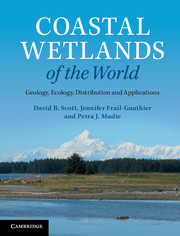Book contents
- Frontmatter
- Contents
- Preface
- List of acronyms and abbreviations
- 1 Introduction: what is covered in this coastal wetlands book?
- 2 Physical aspects: geological, oceanic and climatic conditions
- 3 Zonations and plants: development, stressors and adaptations
- 4 Animals in coastal wetlands: zonation, adaptations and energy flow
- 5 Human intervention causing coastal problems
- 6 Coastal wetlands worldwide: climatic zonation, ecosystems and biogeography
- 7 Examples of North American salt marshes and coastal wetlands
- 8 Examples of South American coastal wetlands
- 9 Africa: selected marsh and mangrove areas
- 10 Europe and Asia: a view of what remains
- 11 Australasia: wetlands of Australia and New Zealand
- 12 Applications in geological monitoring: paleoseismology and paleoclimatology
- 13 Applications in conservation of plant biodiversity and agriculture
- 14 Using mesocosms as a way to study coastal wetlands
- 15 Conclusions and future directions
- References
- Index
- Plate section
14 - Using mesocosms as a way to study coastal wetlands
Published online by Cambridge University Press: 05 July 2014
- Frontmatter
- Contents
- Preface
- List of acronyms and abbreviations
- 1 Introduction: what is covered in this coastal wetlands book?
- 2 Physical aspects: geological, oceanic and climatic conditions
- 3 Zonations and plants: development, stressors and adaptations
- 4 Animals in coastal wetlands: zonation, adaptations and energy flow
- 5 Human intervention causing coastal problems
- 6 Coastal wetlands worldwide: climatic zonation, ecosystems and biogeography
- 7 Examples of North American salt marshes and coastal wetlands
- 8 Examples of South American coastal wetlands
- 9 Africa: selected marsh and mangrove areas
- 10 Europe and Asia: a view of what remains
- 11 Australasia: wetlands of Australia and New Zealand
- 12 Applications in geological monitoring: paleoseismology and paleoclimatology
- 13 Applications in conservation of plant biodiversity and agriculture
- 14 Using mesocosms as a way to study coastal wetlands
- 15 Conclusions and future directions
- References
- Index
- Plate section
Summary
Key points
Anthropogenic impacts have destroyed many salt marshes and mangroves; we are now trying to rebuild them for the ecosystem services they provide; although individual studies and experiments may not answer all questions, they provide valuable insights to effective restoration means; appropriate experiments lead to best methods for achieving high success rates; mesocosms can provide information on effects of future impacts from sea level rise, pollution and biological invasions; more global collaboration with experimental efforts is required to reduce wasted time, energy and finances on overlapping ‘trial-and-error’ experiments and evaluators of success; examples are given of various coastal wetland restoration and construction projects worldwide; there is also strong need for individual research teams to search current subject literature and collaborate with multidisciplinary teams to achieve the best outcomes efficiently and economically.
Why make experimental studies in coastal wetlands?
There are many ways to study coastal wetlands, for just as many purposes. Experimentally, microcosms, mesocosms, whole-system studies (i.e. in situ) and even mathematical models (defined in Table 14.1) can give detailed information on the ecology, sedimentology and hydrology of a salt marsh or mangrove system, answering specific research questions that might be missed in basic observational field studies. The purposes of experimental work include pollution impact and remediation, creating and restoring salt marshes, impacts of biological invaders, to modelling effects of sea level rise. This chapter introduces the principles of mesocosm studies and some of the experimental work done in coastal wetlands, giving various global examples.
- Type
- Chapter
- Information
- Coastal Wetlands of the WorldGeology, Ecology, Distribution and Applications, pp. 279 - 296Publisher: Cambridge University PressPrint publication year: 2014



